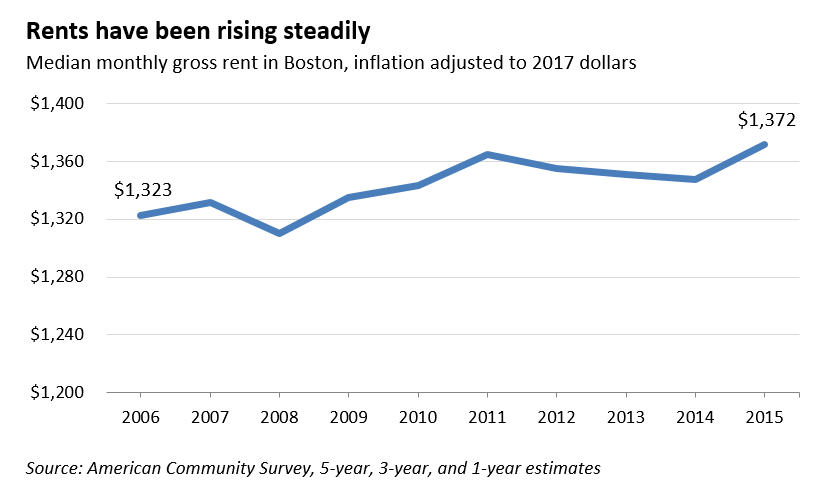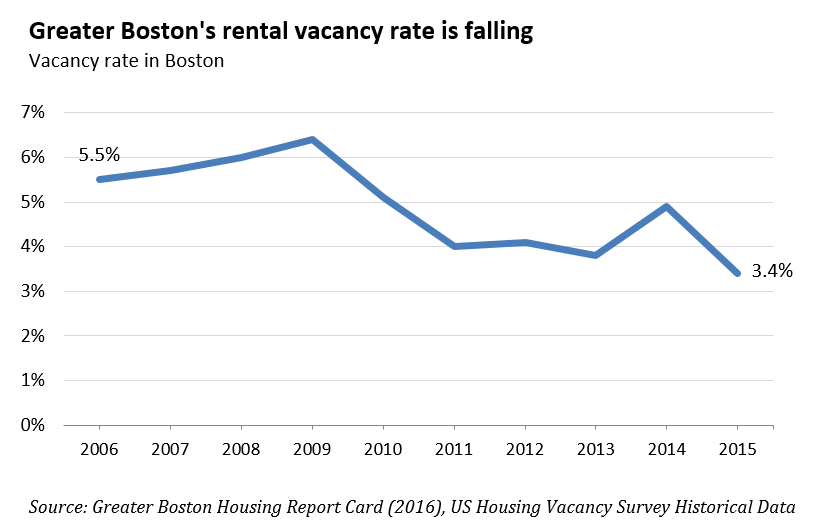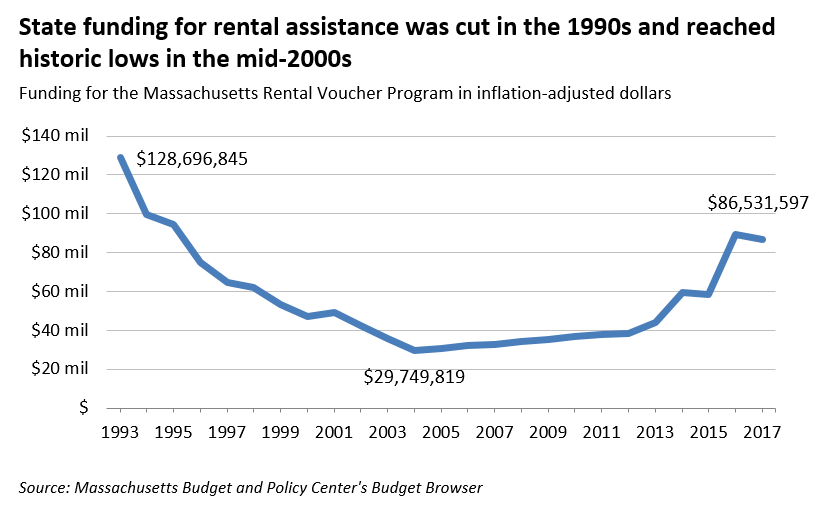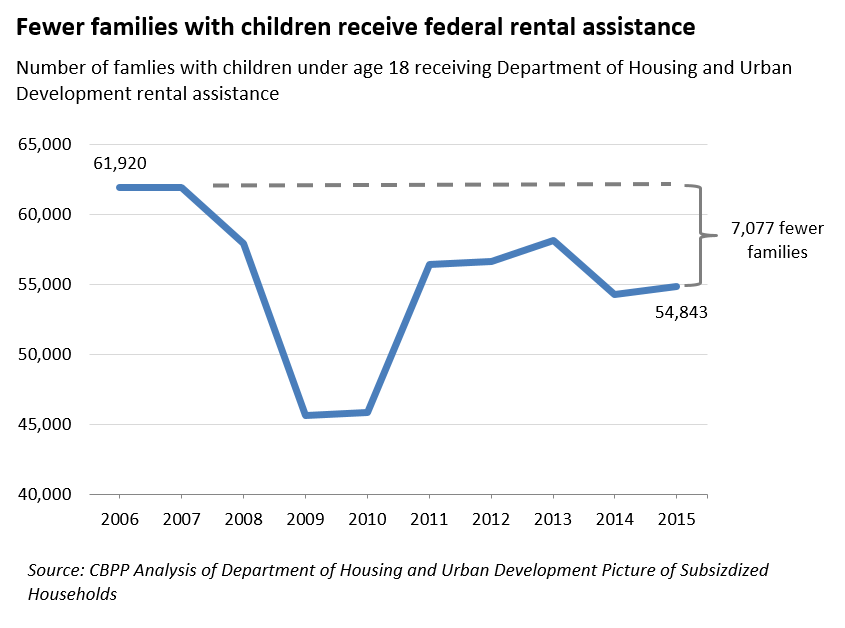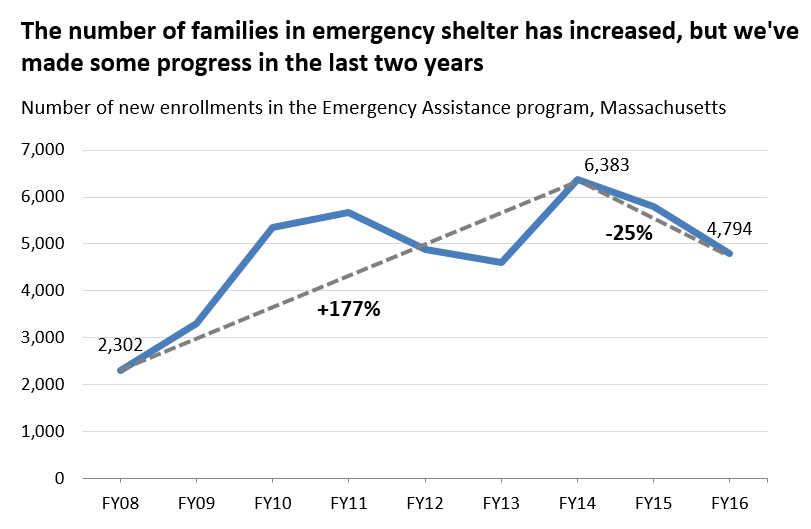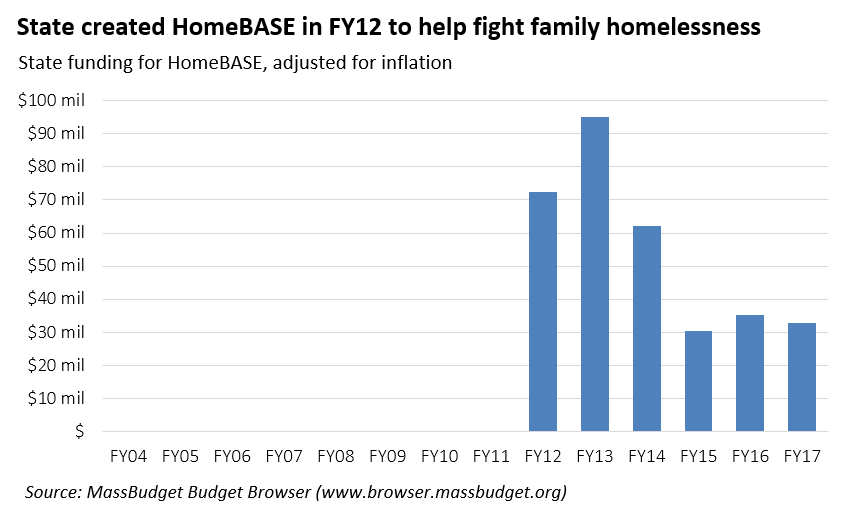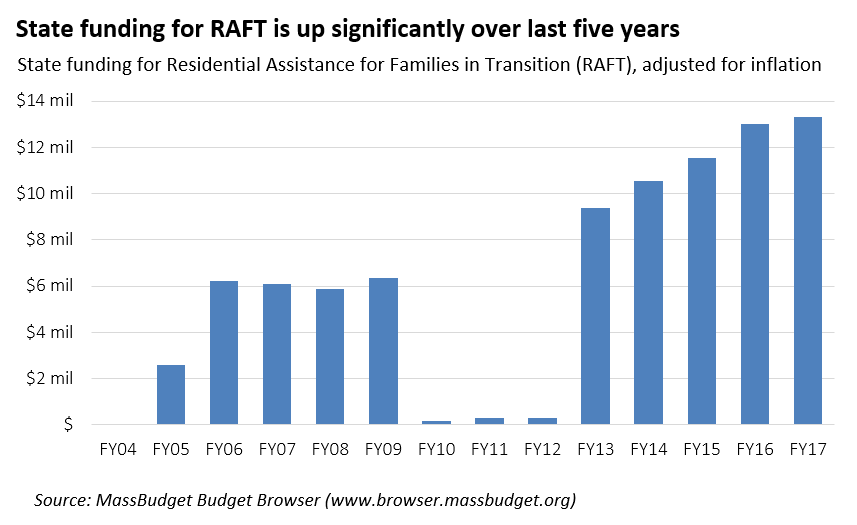Three Causes of Boston's Decade-Long Rise in Homelessness... And Recent Signs of Progress
By Luc Schuster and Anise Vance
May 16, 2017
Against a backdrop of economic growth and relative affluence, Boston’s homeless family population grew significantly over the last decade. While we’ve made some very recent progress (see last section of this brief for detail), family homelessness grew by nearly 75 percent since 2007, according to a recent report from the Boston Foundation. Three key trends that likely played a role in this increase:
- The number of families in poverty increased, especially during the Great Recession.
- Housing costs have risen and fewer affordable rental units are available.
- Public funding for housing programs has been cut.
Growing family homelessness is particularly concerning in Boston because the country as a whole trended in the opposite direction; nationally, family homelessness dropped by 15 percent.
1. The Number of Families in Poverty Increased, Especially During the Great Recession
Poverty and homelessness are tightly correlated. When poverty rises, homelessness is also likely to rise. Families living with incomes below the official poverty threshold—for instance, $20,090 annually for a family of three—are likely struggling to afford housing.
In Boston, family poverty increased during the Great Recession and remains at elevated levels even though we are several years into an economic recovery. From 2006 to 2015, the family poverty rate rose from 16 percent to 17 percent. Boston’s slowly growing family poverty rate, along with an increase in the general population of families, means that more families are currently in poverty than were a decade ago. In 2006, the number of families in poverty was 17,018. By 2015, it had grown to 20,755.
A closer look at the numbers reveals that among families in poverty, those in the lowest income bracket—earning less than $10,000 a year—increased significantly as well. In 2015, 9,981 families earned less than $10,000, well above the 8,601 families that earned less than $10,000 in 2006.
2. Housing Costs Have Risen and Fewer Rental Units Are Available
While rising poverty has been a challenge nationwide—especially during the Great Recession—a couple of housing-related challenges have been more pronounced here than in many other parts of the country: rising rents and low vacancy rates.
Since 2006, the median monthly gross rent in Boston has increased by about $50. Over the course of a year, this increase amounts to $600, a sizable portion of the earnings of many families.
The city’s shrinking vacancy rate, which fell from 5.5 percent in 2006 to 3.4 percent in 2015, compounds the challenge of rising rents. As Boston’s housing market becomes increasingly competitive, those earning the least are at greatest risk of being squeezed out and ultimately becoming homeless.
The shrinking vacancy rate in Boston is further exacerbated by the lack of affordable housing production. Affordable housing units occupy a decreasing share of the total new units being built. From 2011 to 2016, 18 percent of new housing permits were for affordable units, down from 26 percent in the years between 2004 and 2010, and 39 percent in the years between 1996 and 2003.
3. Low Levels of Public Rental Assistance
Public rental assistance is one key resource that can help families earning less and paying more for housing steer clear of homelessness.
In Massachusetts, state funding for rental assistance, through the Massachusetts Rental Voucher Program (MRVP), fell throughout most of the 1990s. Funding of MRVP reached historic lows during the same period that family homelessness was rising. In 2004, the program received less than $30 million—compared with almost $100 million a decade earlier. Funding did not rise above $40 million again until 2013.
Further exacerbating the problem, federal rental assistance for families with children under the age of 18 declined from the mid-2000s onward. Between 2006 and 2015, the number of families with children receiving federal rental assistance fell by 7,077.
Fortunately, Family Homelessness Has Declined over the Last Two Years
In the years immediately following the onset of the Great Recession, family shelter usage funded by the Emergency Assistance program grew sharply. Massachusetts is the only state with a “right to shelter” law, meaning that any eligible family must be provided shelter by the state, regardless of budget constraints (New York City and the District of Columbia are the two other jurisdictions with a right to shelter law). This means that when homelessness increases in Massachusetts, shelter usage usually does too.
But it’s worth noting that statewide we have made some important progress in reversing a portion of this increase over the last two years, with shelter usage dropping 25 percent between FY 2014 and FY 2016 (4,794 new enrollments, down from 6,383). See the last section of this brief for detail on what might have led to this partial reversal.
Two factors in particular may have contributed to this decline: 1) the continued economic recovery, which may have lifted some families out of deep poverty; and 2) new state investments in diversion from homelessness and in longer-term rental supports.
In FY 2012, the state created the HomeBASE program as part of an effort to address the challenge of rising family homelessness. HomeBASE is designed to help divert families eligible for emergency shelter into permanent housing instead. It also helps families already in shelter move into permanent housing by paying for things like moving costs and first and last month’s rent. Currently, HomeBASE provides up to $8,000 per family. HomeBASE’s initial three-year funding allocation, combined with ongoing support at lower levels from FY 2015 through FY 2017, may have helped reduce family shelter enrollments in recent years.
Additionally, state funding for Residential Assistance for Families in Transition (RAFT) is up significantly since FY 2013. Similar to HomeBASE in that it helps low-income families avoid homelessness, RAFT provides direct rental assistance for families who are already in housing but at risk of becoming homeless. RAFT serves some families that are simultaneously eligible for HomeBASE but also serves families whose incomes are just high enough that they don’t qualify for HomeBASE or Emergency Assistance. RAFT provides $4,000 per year and is usually a one-time support for families at risk of losing their housing.
Very low state funding for RAFT from FY 2010 through FY 2012 coincided with the federal government providing an infusion of stimulus funding for Rapid Rehousing through the American Recovery and Reinvestment Act (ARRA). Rapid Rehousing served a similar function to RAFT, and the state restored funding for RAFT after federal ARRA funding ended.
Finally, recent increases to the Massachusetts Rental Voucher Program (shown in section 3 above) also may have helped keep families who were at risk of falling into homelessness in permanent housing instead.

